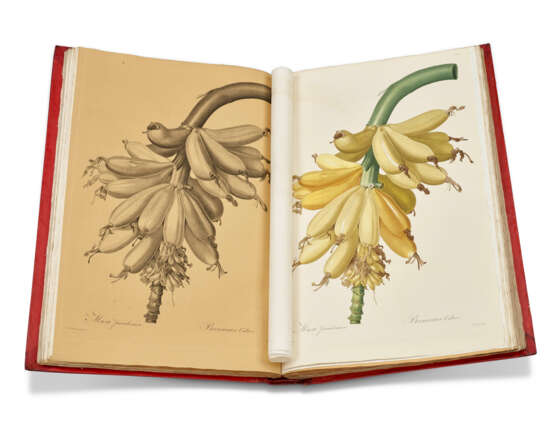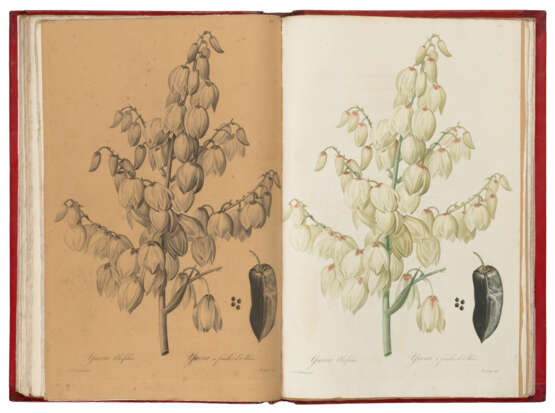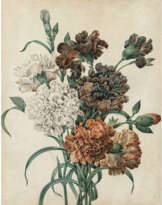ID 794358
Los 215 | REDOUTÉ, Pierre-Joseph (1759-1840).
Schätzwert
£ 300 000 – 400 000
Les Liliacées. Text by Augustin-Pyramus de Candolle (vols. I-IV), François Delaroche (vols. V-VI) and Alire Raffeneau-Delile (vols. VII-VIII). Paris: Imprimerie de Didot jeune for the author, 1805-1816.
Association copy of a rare, special issue set with the plates in two states, of Redouté’s largest and most ambitious work and a masterpiece of botanical illustration. Les Liliacées was the first of Redouté’s three great collections of botanical prints and his plates here ‘constitute the highest peak of [his] artistic and botanical achievement’ (Hunt Redoutéana, p. 21). Many of the flowers depicted in Les Liliacées were drawn at Empress Josephine’s Malmaison, and he named a rare specimen after the empress, Amaryllis josephinae, illustrating its luscious beauty as the sole double-page plate in the work. The great beauty of his work has somewhat overshadowed his scientific contribution, but for each lily Redouté gives the history, nomenclature, plate description and observations. His work on lilies was particularly useful in providing detailed images of a fragile plant impossible to preserve as a dried specimen. Also, the work is far more than a monograph of the lily, as the specimens illustrated ‘encompass petaloid monocotyledons in general’ (Blunt and Stearn): irises, orchids, heliconias, agaves, amaryllis, and bromeliads, including pineapple and banana.
Les Liliacées was limited to 280 copies issued in 80 parts, beginning in 1802, but its early success emboldened Redouté to offer even more deluxe, special issues on large paper. The present copy is one such special issue, printed on grand-papier and with a double suite of plates, one in colour and one in black and white on ochre paper. Only a handful of copies are known. In addition to the double-suite issue was an issue on even larger paper; whereas the grand-papier issue is c.30mm taller than the ordinary issue, the largest issue is a further c.40mm taller. According to Sitwell and Blunt, production of this largest-paper issue began in 1807 and from volume III was produced concurrently with both the ordinary and double-suite issues. In a special preface to this grand-papier issue, Redoute announces this ‘seconde edition peu nombreuse’ with larger margins to heighten the grace of the images to make it even more perfect and desirable to bibliophiles. He projected an edition of 40, but an annotation signed by Redouté in an ordinary copy at the Lindley Library (Royal Horticultural Society) notes that only 18 sets were in fact completed.
The earliest owner of this set was Martin Bossange, a leading French book dealer and publisher who included among his authors (from 1824) Redouté. In 1829, Bossange established a competition under the auspices of the Société d'Horticulture, Paris, to promote improved cultivation of corn. The competition was judged by eminent members of the society, including M. Berlèse, and the prize, donated by Bossange, was the present set of Les Liliacées, described in the Society’s proceedings of 1830 as ‘huit volumes grand in-fol. du magnifique ouvrage des Liliacées [avec] … doubl. fig. imprimées en noir et peintes en couleur, exemplaire unique de la valuer 4000 fr.’ The prize and its presentation to the winner, Mr. Godefroy, is recorded on spine labels lettered in gilt. Stafleu and Cowan 8747; Nissen BBI 1597; Great Flower Books p.71; Dunthorne 231; I. MacPhail, 'Books Illustrated by Redouté' in G. H. M. Lawrence A catalogue of Redoutéana exhibited at the Hunt Botanical Library, Pittsburgh: 1963. 10.
In his quest for producing the most true and beautiful botanical engravings Redouté also perfected the art of printing the images in black-and-white. He had learned on his English sojourn that running off a number of black-and-white impressions took the unnatural sharpness off the plates. He then chose an ochre paper to print special impressions for deluxe copies in order to subdue the contrast and enable ‘the reader to appreciate the purity of his engravers’ stipple and roulette technique’ (Bridson and Wendel, Hunt Printmaking in the Service of Botany, 25). Stafleu and Cowan 8747; Nissen BBI 1597; Great Flower Books p.71; Dunthorne 231; I. MacPhail, 'Books Illustrated by Redouté' in G. H. M. Lawrence A catalogue of Redoutéana exhibited at the Hunt Botanical Library, Pittsburgh: 1963,10.
8 volumes, folio (542 x 353mm). Half-titles, title-page of vol. I reissued with the date 1805, Redoute's preface printed for this issue [‘seconde édition peu nombreuse’] in vol. I, 485 stipple engraved plates printed in colour and finished by hand (except plate 372, the Amaryllis bulb, uncoloured as usual), plates numbered 1-486, with the folding plate of the Amaryllis Joséphine numbered 370⁄71, and with an additional suite of plates printed in black on ochre paper, second state of pl. 95 with the caption Tradescantia Virginica, plates 427-428 in variant states: Plate 427 (accompanying text for Narcissus intermedius) signed on ochre by Langlois with caption Narcissus intermedius and on colour plate also by Langlois but with caption Narcissus laetus, plate 428 (accompanying text for Narcissus laetus) signed in both suites by Bessin with caption Narcissus laetus, plate 429 (Narcissus dubius misnumbered ‘428’. Paperstocks: text and colour plates variously on paper either unmarked or marked O DENT & C or A. COURTALIN; uncoloured plates on unwatermarked ochre paper. (Lacking the engraved portrait of Redouté and dedication to Chaptal in volume I, light occasional spotting and toning, heavier in about 13 plates, minor offsetting from the ochre plates, about 5 colour plates shaved along the platemark.) Contemporary French red half straight-grained morocco, straight-grained textured paper over boards, flat spines ruled and lettered gilt, black label at foot of each spine lettered to record the set as a prize awarded to Mr. Godefroy, 1831 (lightly rubbed, light wear and minor repairs at spine ends and hinges). Provenance: [Mr Bossange père, 1829 donor of the set to be awarded as a horticultural prize] – Mr Godefroy, recipient of the Bossange prize for the cultivation of corn, 1831, by the Société d'Horticulture, Paris (binding) – [Private Collection, New York (sold Sotheby's NY, 5 June 1996, lot 322)].
Special notice
No VAT on hammer price or buyer's premium.
| Künstler: | Pierre-Joseph Redoute (1759 - 1840) |
|---|---|
| Herkunftsort: | Westeuropa, Frankreich, Europa |
| Kategorie des Auktionshauses: | Gedruckte Bücher |
| Künstler: | Pierre-Joseph Redoute (1759 - 1840) |
|---|---|
| Herkunftsort: | Westeuropa, Frankreich, Europa |
| Kategorie des Auktionshauses: | Gedruckte Bücher |
| Adresse der Versteigerung |
CHRISTIE'S 8 King Street, St. James's SW1Y 6QT London Vereinigtes Königreich | |
|---|---|---|
| Vorschau |
| |
| Telefon | +44 (0)20 7839 9060 | |
| Aufgeld | see on Website | |
| Nutzungsbedingungen | Nutzungsbedingungen |

















